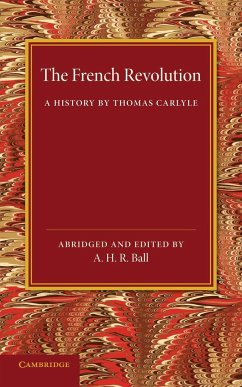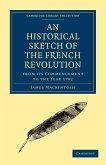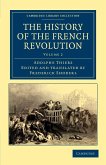- Broschiertes Buch
- Merkliste
- Auf die Merkliste
- Bewerten Bewerten
- Teilen
- Produkt teilen
- Produkterinnerung
- Produkterinnerung
This book contains a series of extracts from Thomas Carlyle's influential three-volume work The French Revolution: A History (1837).
Andere Kunden interessierten sich auch für
![Global Ramifications of the French Revolution Global Ramifications of the French Revolution]() Joseph Klaits / Michael Haltzel (eds.)Global Ramifications of the French Revolution61,99 €
Joseph Klaits / Michael Haltzel (eds.)Global Ramifications of the French Revolution61,99 €![An Historical Sketch of the French Revolution from Its Commencement to the Year 1792 An Historical Sketch of the French Revolution from Its Commencement to the Year 1792]() James MackintoshAn Historical Sketch of the French Revolution from Its Commencement to the Year 179258,99 €
James MackintoshAn Historical Sketch of the French Revolution from Its Commencement to the Year 179258,99 €![The History of the French Revolution The History of the French Revolution]() Adolphe ThiersThe History of the French Revolution48,99 €
Adolphe ThiersThe History of the French Revolution48,99 €![Revolution and Political Conflict in the French Navy 1789 1794 Revolution and Political Conflict in the French Navy 1789 1794]() William S. CormackRevolution and Political Conflict in the French Navy 1789 179461,99 €
William S. CormackRevolution and Political Conflict in the French Navy 1789 179461,99 €![The History of the French Revolution The History of the French Revolution]() Adolphe ThiersThe History of the French Revolution44,99 €
Adolphe ThiersThe History of the French Revolution44,99 €![Inventing the French Revolution Inventing the French Revolution]() Keith Michael BakerInventing the French Revolution38,99 €
Keith Michael BakerInventing the French Revolution38,99 €![The Genesis of the French Revolution The Genesis of the French Revolution]() Bailey StoneThe Genesis of the French Revolution55,99 €
Bailey StoneThe Genesis of the French Revolution55,99 €-
-
-
This book contains a series of extracts from Thomas Carlyle's influential three-volume work The French Revolution: A History (1837).
Hinweis: Dieser Artikel kann nur an eine deutsche Lieferadresse ausgeliefert werden.
Hinweis: Dieser Artikel kann nur an eine deutsche Lieferadresse ausgeliefert werden.
Produktdetails
- Produktdetails
- Verlag: Cambridge University Press
- Seitenzahl: 272
- Erscheinungstermin: 3. Februar 2014
- Englisch
- Abmessung: 203mm x 127mm x 16mm
- Gewicht: 331g
- ISBN-13: 9781107652972
- ISBN-10: 1107652979
- Artikelnr.: 41196195
- Herstellerkennzeichnung
- Libri GmbH
- Europaallee 1
- 36244 Bad Hersfeld
- gpsr@libri.de
- Verlag: Cambridge University Press
- Seitenzahl: 272
- Erscheinungstermin: 3. Februar 2014
- Englisch
- Abmessung: 203mm x 127mm x 16mm
- Gewicht: 331g
- ISBN-13: 9781107652972
- ISBN-10: 1107652979
- Artikelnr.: 41196195
- Herstellerkennzeichnung
- Libri GmbH
- Europaallee 1
- 36244 Bad Hersfeld
- gpsr@libri.de
Thomas Carlyle was a British writer, historian, and philosopher who was born on December 4, 1795, and died on February 5, 1881. He was from the Scottish Lowlands. He was one of the most important writers of the Victorian age and had a big impact on art, literature, and philosophy in the 1800s. Born in Ecclefechan, Dumfriesshire, Scotland, Carlyle went to the University of Edinburgh and invented the Carlyle circle while there. When the arts course was over, he worked as a schoolmaster and studied to become a minister in the Burgher Church. He gave up on these and other things before he decided to write for the Edinburgh Encyclopaedia and work as a translator. Early on, he was successful by introducing little-known German literature to English readers through translations, his 1825 book Life of Friedrich Schiller, and review essays he wrote for a number of magazines. His first big book was called Sartor Resartus and came out between 1833 and 1834. After moving to London, his book The French Revolution (1837) made him famous, which led to the collection and reissue of his writings as Miscellanies.
Preface
Introduction
1. Death of Louis XV
2. The new age
3. The notables
4. The states-general
5. The third estate
6. To arms!
7. Fall of the Bastille
8. Revolution
9. The Menads
10. The King at Paris
11. The army
12. The clubs
13. Mirabeau
14. Flight of the King
15. The constitution
16. Europe
17. The Jacobins
18. The Marseilleise
19. The Swiss
20. The commune
21. The September massacres
22. The cannonade of Valmy
23. Execution of Louis XVI
24. Girondins and mountain
25. The committees
26. The new calendar
27. Death of Marat
28. Marie-Antoinette
29. The reign of terror
30. The feast of reason
31. The new Paris
32. Danton, no weakness
33. Feast of the être suprême
34. Robespierre
35. Decline of revolution
36. The army
37. The whiff of grapeshot
38. Finis
Appendixes
Index of proper names
Glossary.
Introduction
1. Death of Louis XV
2. The new age
3. The notables
4. The states-general
5. The third estate
6. To arms!
7. Fall of the Bastille
8. Revolution
9. The Menads
10. The King at Paris
11. The army
12. The clubs
13. Mirabeau
14. Flight of the King
15. The constitution
16. Europe
17. The Jacobins
18. The Marseilleise
19. The Swiss
20. The commune
21. The September massacres
22. The cannonade of Valmy
23. Execution of Louis XVI
24. Girondins and mountain
25. The committees
26. The new calendar
27. Death of Marat
28. Marie-Antoinette
29. The reign of terror
30. The feast of reason
31. The new Paris
32. Danton, no weakness
33. Feast of the être suprême
34. Robespierre
35. Decline of revolution
36. The army
37. The whiff of grapeshot
38. Finis
Appendixes
Index of proper names
Glossary.
Preface
Introduction
1. Death of Louis XV
2. The new age
3. The notables
4. The states-general
5. The third estate
6. To arms!
7. Fall of the Bastille
8. Revolution
9. The Menads
10. The King at Paris
11. The army
12. The clubs
13. Mirabeau
14. Flight of the King
15. The constitution
16. Europe
17. The Jacobins
18. The Marseilleise
19. The Swiss
20. The commune
21. The September massacres
22. The cannonade of Valmy
23. Execution of Louis XVI
24. Girondins and mountain
25. The committees
26. The new calendar
27. Death of Marat
28. Marie-Antoinette
29. The reign of terror
30. The feast of reason
31. The new Paris
32. Danton, no weakness
33. Feast of the être suprême
34. Robespierre
35. Decline of revolution
36. The army
37. The whiff of grapeshot
38. Finis
Appendixes
Index of proper names
Glossary.
Introduction
1. Death of Louis XV
2. The new age
3. The notables
4. The states-general
5. The third estate
6. To arms!
7. Fall of the Bastille
8. Revolution
9. The Menads
10. The King at Paris
11. The army
12. The clubs
13. Mirabeau
14. Flight of the King
15. The constitution
16. Europe
17. The Jacobins
18. The Marseilleise
19. The Swiss
20. The commune
21. The September massacres
22. The cannonade of Valmy
23. Execution of Louis XVI
24. Girondins and mountain
25. The committees
26. The new calendar
27. Death of Marat
28. Marie-Antoinette
29. The reign of terror
30. The feast of reason
31. The new Paris
32. Danton, no weakness
33. Feast of the être suprême
34. Robespierre
35. Decline of revolution
36. The army
37. The whiff of grapeshot
38. Finis
Appendixes
Index of proper names
Glossary.








